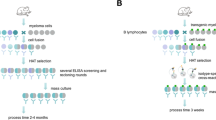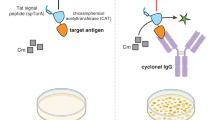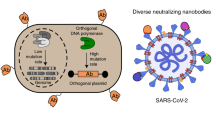Abstract
A system which confers selective growth advantage to cells expressing particular surface proteins would be extremely desirable, for such a technique would allow the study of receptors using somatic cell genetic techniques such as DNA-mediated cell transformation and selection of over-producing cell variants. Polypeptides bound to surface receptors, and antibodies bound to surface antigens generally are taken up efficiently by cells by endocytotic mechanisms. Several investigators have accordingly developed useful techniques for selection against cells expressing surface receptors and antigens, using hormones and antibodies conjugated to toxins1,2. We reasoned that conjugation of nutrients to antibodies or hormones conversely might permit a positive selective pressure to be applied in appropriately constituted medium. We report here that monoclonal antibodies to cell-surface antigens will indeed deliver nutritional iron and selenium to cultured cells in an antigen-specific manner.
This is a preview of subscription content, access via your institution
Access options
Subscribe to this journal
Receive 51 print issues and online access
$199.00 per year
only $3.90 per issue
Buy this article
- Purchase on Springer Link
- Instant access to full article PDF
Prices may be subject to local taxes which are calculated during checkout
Similar content being viewed by others
References
Davis, B. T.-M. & Preston, J. F. Science 213, 1385–1387 (1981).
Blythman, H. E. et al. Nature 290, 145 (1981).
Bothwell, M. A., Schechter, A. L. & Vaughn, K. Cell 21, 857–866 (1980).
Block, T. M. & Bothwell, M. A. J. Neurochem. (in the press).
Barnes, D. & Sato, G. Cell 22, 649–655 (1980).
Bottenstein, J. A. & Sato, G. H. Proc. natn. Acad. Sci. U.S.A. 76, 514–517 (1979).
Pearse, B. M. F. Proc. natn. Acad. Sci. U.S.A. 79, 451–455 (1982).
Granick, S. Physiol. Rev. 31, 497–510 (1951).
Murakami, H. et al. Proc. natn. Acad. Sci. U.S.A. 79, 1158–1162 (1982).
Ex, P. L., Prowse, S. J. & Jenkins, C. R. Immunochemistry 15, 429–436 (1978).
Kennet, R. H. in Monoclonal Antibodies (eds Kennet, R. H., McKearn, T. K. & Bechtol, K. B.) 376 (Plenum, New York, 1980).
Gilvarg, C. in The Future of Antibiotherapy and Antibiotic Research (eds Ninet, L., Bost, P. F., Bonanchaud, D. & Flount, J.) 351–361 (Academic, London, 1981).
Wigler, M. et al. Cell 16, 777–785 (1979).
Block, T. & Hughes, R. G. Cold Spring Harbor Workshop on Herpes Viruses IV, 79–80 (1979).
Stanley, J. R., Hawley-Nelson, P., Yuspa, S., Sheroch, E. M. & Katz, S. I. Cell 24, 897–903 (1981).
Kishida, Y., Olsen, R. B., Berg, R. A. & Prokup, D. J. J. Cell Biol. 64, 331–339 (1975).
Laemmli, U. K. Nature 227, 680–685 (1970).
Author information
Authors and Affiliations
Rights and permissions
About this article
Cite this article
Block, T., Bothwell, M. Use of iron- or selenium-coupled monoclonal antibodies to cell-surface antigens as a positive selection system for cells. Nature 301, 342–344 (1983). https://doi.org/10.1038/301342a0
Received:
Accepted:
Issue Date:
DOI: https://doi.org/10.1038/301342a0
This article is cited by
-
Properties of PC12 pheochromocytoma cells transplanted to the adult rat brain
Experimental Brain Research (1986)
-
Expression and regulation of human low-density lipoprotein receptors in Chinese hamster ovary cells
Nature (1984)
Comments
By submitting a comment you agree to abide by our Terms and Community Guidelines. If you find something abusive or that does not comply with our terms or guidelines please flag it as inappropriate.



